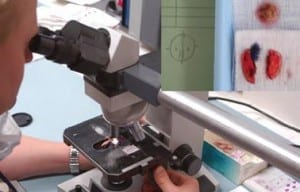After finding out it necessary to undergo Mohs Micrographic Surgery to remove a skin cancer, patients often have a number if questions. One common question that patients have is regarding the amount of time that the surgery will take. The honest answer is that it is different for each person.
“Unfortunately, this is one question that is difficult to answer,” says Dr. Adam Mamelak, a board certified Dermatologist and Mohs Micrographic Surgeon in Austin, Texas. “After removing a section of cancerous tissue, that tissue is evaluated to see if any roots are left behind. If there are cancerous roots present, another stage of tissue must be removed. The process is repeated until no cancer is left behind. But the total number of stages a patient will need is really hard to predict.”
The actual surgery part of the procedure is relatively quick. “It might take 5 or 10 minutes to remove the skin cancer,” says Dr. Mamelak. “In many cases, it’s similar to the amount of time it takes to perform a skin biopsy.” However, it is the processing in the lab that can take some time, anywhere from 20 minutes to over an hour. “It all really depends on how intricate the tissue specimen is, how many pieces we have to process, if we do any special stains on the tissue to highlight the tumor cells.”
It is best to plan on spending the greater part of your day in the office when undergoing Mohs Micrographic Surgery. On average, patients typically require two stages to remove their skin cancer, but can require as little as a single stage, while another might need more than five stages.
 While the tissue is being processed in the lab between these stages, there is a waiting period where a temporary bandage is placed over the surgical site. “We have a Mohs lounge at Sanova Dermatology where patients can relax, read or watch TV while waiting for their slides. Patients are encouraged to bring a book, their laptop, or browse magazines while they wait. “Often patients bring in a family member or friend to help the time pass between the stages of Mohs surgery, and we notice that it does help keep their spirits up and relieve some of the stress and anxiety that is natural to feel with these procedures.” Having someone accompany a patient is also helpful, as the extent of the surgery is usually not known until the tissue is being removed.
While the tissue is being processed in the lab between these stages, there is a waiting period where a temporary bandage is placed over the surgical site. “We have a Mohs lounge at Sanova Dermatology where patients can relax, read or watch TV while waiting for their slides. Patients are encouraged to bring a book, their laptop, or browse magazines while they wait. “Often patients bring in a family member or friend to help the time pass between the stages of Mohs surgery, and we notice that it does help keep their spirits up and relieve some of the stress and anxiety that is natural to feel with these procedures.” Having someone accompany a patient is also helpful, as the extent of the surgery is usually not known until the tissue is being removed.
Another factor that adds to the time of surgery is the reconstruction after the surgery has taken place. “Closing the wound after surgery is unique for each patient, and varies based on the size of the surgical defect, or total amount of tissue that is removed,” informs Dr. Mamelak. “Methods of reconstruction can range from a simple stitch, to the stretching of skin over an area, or even a skin graft for larger areas of removal.” After closure, the patient is free to leave and then asked to return within a two week time frame to evaluate the area and remove stitches if necessary.
The best way to be informed of the time frame of your surgery is to consult with your Mohs Surgeon, as they are more knowledgeable of your cancer’s borders and severity.
Contact Us
If you have been diagnosed with skin cancer, or have questions about Mohs surgery, please contact Dr. Mamelak at Sanova Dermatology today. We look forward to helping you with all of your skin care concerns.
